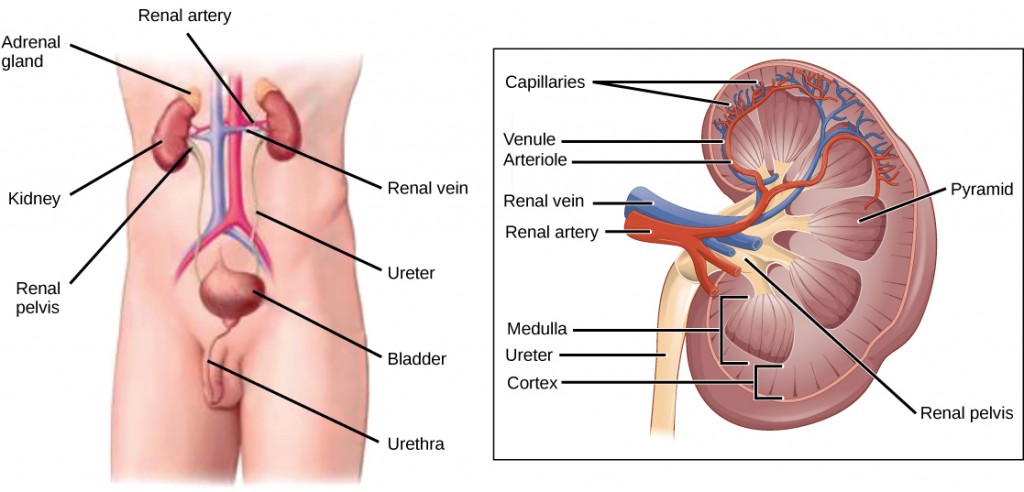3.Human Physiology
3.4 Excretion
Excretion
Dr V Malathi
Theexcretory systemremoves waste products and excess water from the body and helps to maintain homeostasis.
Excretion
The process of eliminating metabolic wastes and toxins from the body is called excretion.
Excretion maintains the body’s internal environment and prevents damage from toxic substances.
Some of the specific waste products that must be excreted from the body include
- carbon dioxide produced from cellular respiration,
- ammonia and urea produced from protein catabolism, and
- uric acid produced from nucleic acid catabolism.
Excretory System Organs
- Kidneys: The primary organs of the excretory system are the kidneys which are a pair of bean-shaped structures that are located just below the liver in the body cavity. They filter blood to remove urea, excess salts, and water, forming urine. There are more than a million tiny units called nephrons in each kidneys. The nephrons functions to filter blood containing the metabolic wastes from cells. All the blood in the human body is filtered about 60 times a day by the kidneys. The functions of the nephrons are : removal of wastes, concentrate them, and form urine which is collected in the bladder.
The three regions of the kidney are
-
-
- Outer cortex: contains the nephrons—the functional unit of the kidney
- Middle medulla
- renal pelvis : collects the urine and leads to the ureter on the outside of the kidney.

-
The human excretory system” by Charles Molnar and Jane Gair is licensed under CC BY 4.0
- Ureters: Tubes that carry urine from the kidneys to the bladder.
- Bladder: Stores urine until it is excreted.
- Urethra: The duct through which urine is expelled from the body.
- Liver: The liver performs a variety of important tasks, such as producing bile for fat digestion, manufacturing a large number of proteins and other molecules, storing glycogen and other materials, and secreting endocrine hormones. The liver is a vital organ for excretion in addition to doing all of these other duties. Toxins are among the numerous chemicals in the blood that the liver breaks down. For instance, the liver converts ammonia, a toxic byproduct of protein breakdown, into urea, which the kidneys remove from the blood and eliminate as urine. The protein bilirubin, which is produced when red blood cells are broken down as a result of hemoglobin catabolism, is also excreted by the liver in its bile. After passing through the small intestine, the big intestine eliminates the bile as feces.
- Skin: The skin which is a part of the integumentary system excretes sweat , produced by the sweat glands in the dermis . Sweat contains water, salts, and small amounts of urea. Though sweat functions mainly to cool the body and maintain temperature, homeostasis, it also participates in excretion by eliminating the waste
- Lungs: Lungs are in charge of eliminating gaseous waste from the body. Carbon dioxide, a waste product of cellular respiration in all body cells, is the primary waste gas expelled by the lungs. In the lungs’ tiny air sacs known as alveoli, carbon dioxide is diffused from the blood into the surrounding air (shown in the inset diagram). The lungs contribute to the preservation of acid-base balance by eliminating carbon dioxide from the blood. Actually, the blood’s pH regulates how quickly people breathe. As the exhaled air passes past the moist linings of the lungs and other respiratory tract organs, water vapor is also picked up from these organs and is expelled with the carbon dioxide. Trace amounts are in charge of eliminating gaseous waste from the body. Carbon dioxide, a waste product of cellular respiration in all body cells, is the primary waste gas expelled by the lungs. In the lungs’ tiny air sacs known as alveoli, carbon dioxide is diffused from the blood into the surrounding air (shown in the inset diagram). The lungs contribute to the preservation of acid-base balance by eliminating carbon dioxide from the blood. Actually, the blood’s pH regulates how quickly people breathe. As the exhaled air passes past the moist linings of the lungs and other respiratory tract organs, water vapor is also picked up from these organs and is expelled with the carbon dioxide.
- Large Intestine: Removes solid waste and some water in the form of feces. As the last organ in the gastrointestinal tract, the large intestine plays a significant role in the digestion process. Its primary job as an excretory organ is to get rid of solid wastes that are left behind after food is digested and water is extracted from indigestible materials in food waste. Wastes are also gathered in the large intestine from all throughout the body. Bilirubin, a waste product of the liver, is present in bile released into the gastrointestinal tract, for instance. The brown pigment bilirubin is responsible for the distinctive brown color of human feces.
Functions of the Excretory System
- Filtration: Kidneys filter blood to remove waste products.
- Reabsorption: Essential nutrients and water are reabsorbed back into the bloodstream.
- Secretion: Additional waste products are secreted into the urine.
- Excretion: Final removal of urine from the body.
Importance
The excretory system plays a vital role in:
- Regulating fluid balance: Ensuring the body maintains adequate levels of water and salts.
- Maintaining pH balance: Keeping the body’s internal environment stable.
- Removing toxins: Preventing the build-up of harmful substances.
Test your understanding
Mark the parts of the excretory system by Dragging and dropping the options at correct position
Identify the functions of the kidneys by dragging and dropping the correct options in the answer box
Identify the functions of the excretory organs by attempting the quiz given below

